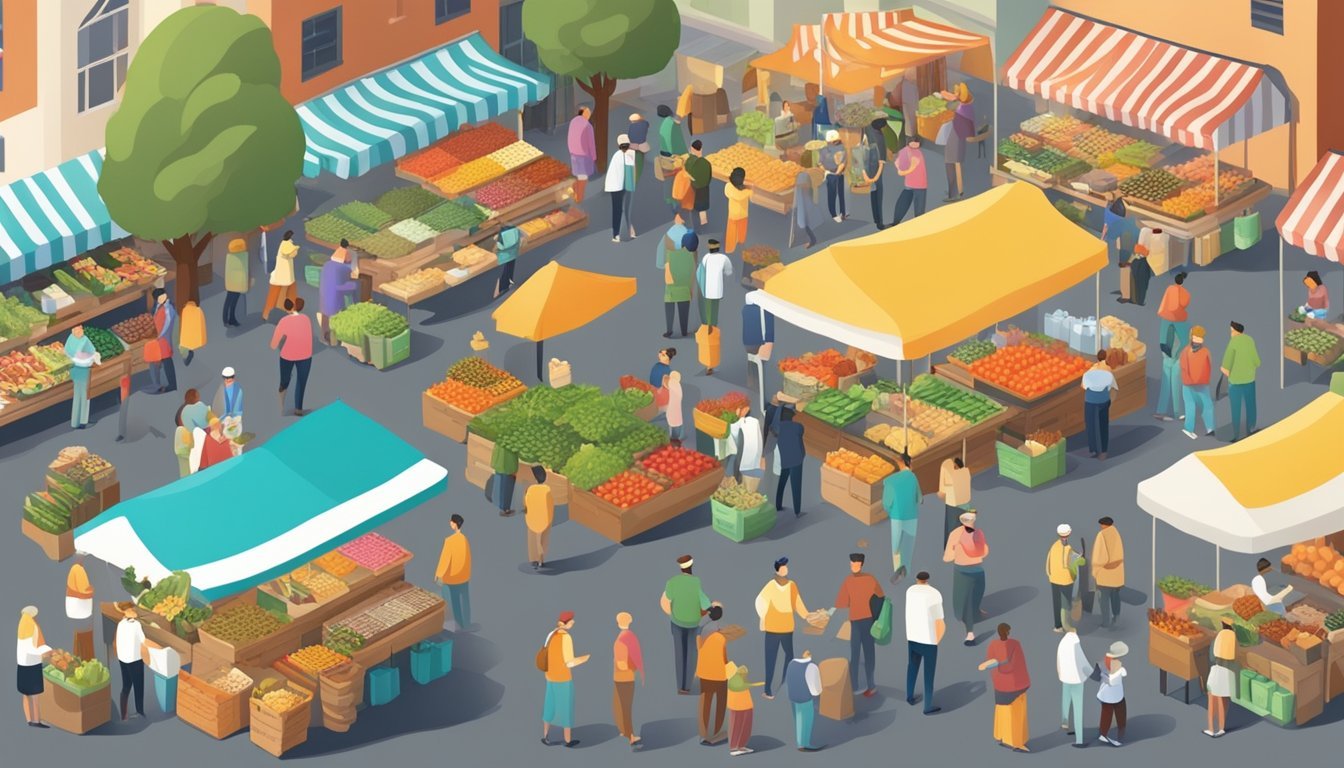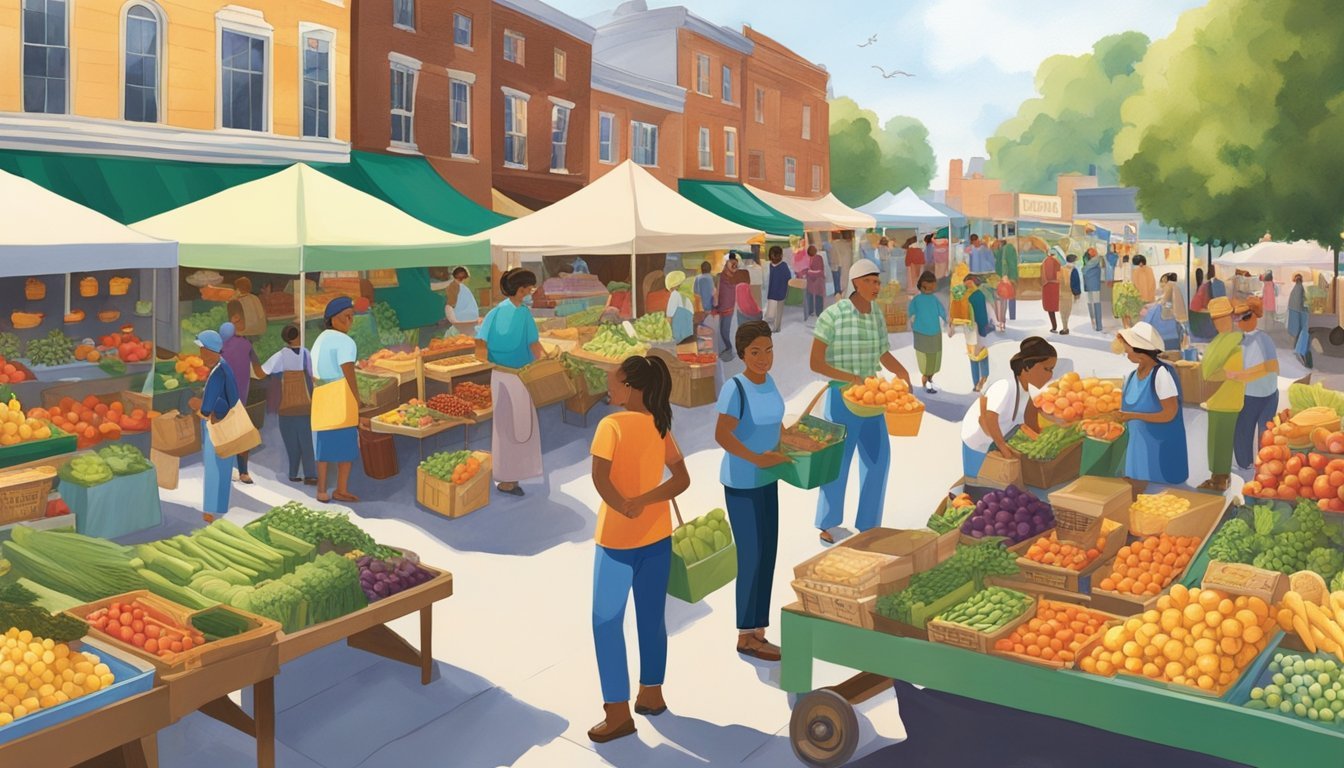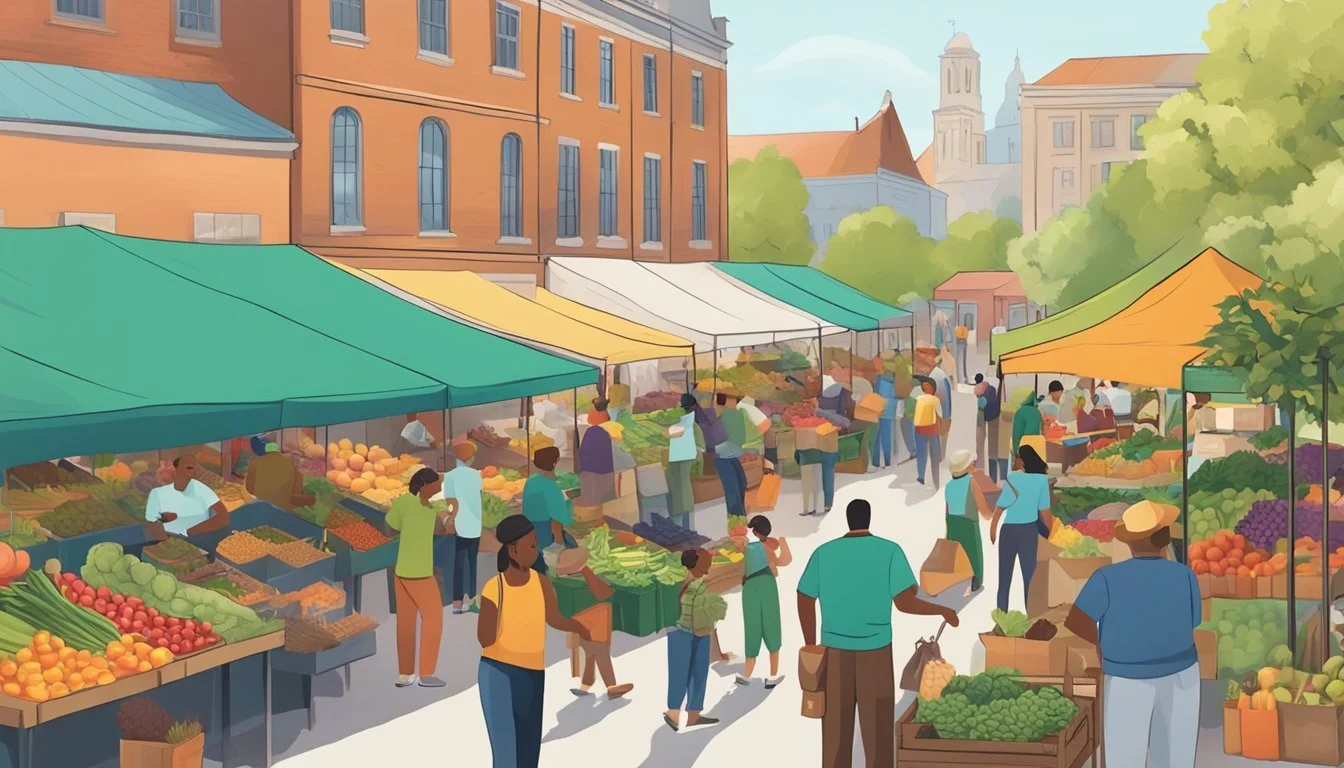The Role of Farmers' Markets in Community Building
Catalysts for Local Solidarity
Farmers' markets across the United States have evolved into focal points for economic development and community engagement. The resurgence of these markets has reconnected rural producers with urban consumers, bolstering local food systems and offering fresh produce to the public. They facilitate networks between growers and their communities, providing a space for direct interaction, which in turn reinforces trust and community spirit.
These markets are not merely sites of transaction but also serve as platforms for public health awareness and environmental sustainability. By offering locally-sourced goods, farmers' markets reduce the carbon footprint associated with food transport and support sustainable agricultural practices. They become intersections where the exchange of goods contributes to the education of consumers about the benefits of healthy eating and the importance of preserving local farming.
Furthermore, as these markets grow, they become critical in shaping the social fabric of neighborhoods. Markets act as open-air gathering spaces where cultural and intergenerational activities can take place, fostering a sense of belonging and community identity. Through this role, farmers' markets contribute significantly to the social and economic vitality of the areas they serve.
Historical Context and Evolution
The historical trajectory of farmers' markets illustrates a shift from simple trade practices to complex socio-economic structures that bolster rural and urban communities alike.
From Barter to Business: The Genesis of Farmers' Markets
Farmers' markets have their roots in the age-old practice of barter, where individuals directly exchanged goods without the use of money. These early gatherings were essential for rural communities to trade surplus produce and livestock. Over time, these markets evolved beyond mere trade sites: they became entrenched in the economic and social frameworks of communities, serving as locale for both business transactions and social interactions.
Modern Farmers' Markets and Their Community Role
Today's farmers' markets play a pivotal role in bridging the gap between urban consumers and rural agriculturalists. They offer economic benefits by enabling farmers to sell their produce directly, eliminating middlemen and fostering fair trade. Studies have recorded a multiplication in the number of farmers' markets from 1,755 in 1994 to 8,761 in 2019, a response not just to economic need but also to an increased demand for sustainable and locally sourced food options. These markets are more than just commercial spaces; they are vital public spaces that enhance community engagement and identity while maintaining their crucial role in local agriculture and economy.
Economic Contributions
Farmers' markets play a significant role in bolstering the local economy by enabling direct marketing, fostering job creation, and providing financial avenues for small-scale farmers.
Supporting Local Economies through Direct Marketing
Farmers' markets enable direct-to-consumer sales, which keep the economic benefits within the community by allowing consumers to purchase goods directly from producers. This direct marketing approach means that more of the consumer's dollar goes to the farm businesses, enhancing their economic viability and contributing to local economies.
Job Creation and Entrepreneurship
These markets are not only venues for food transactions but also serve as incubators for entrepreneurship. They provide opportunities for farmers and artisans to create and sustain jobs within the community, which in turn supports economic development on a local level.
Financial Challenges and Opportunities for Small Farmers
While farmers' markets offer small-scale farmers the chance to engage in direct sales without the need for intermediaries, they also face financial hurdles such as market fees and the costs associated with sustainable practices. Despite these challenges, markets represent an opportunity for these farmers to connect with consumers who value sustainable agriculture and are willing to support their local economy.
Community and Social Dynamics
Farmers' markets play a significant role in fostering community bonds and creating social hubs that are both vibrant and inclusive. They offer a platform where community engagement extends beyond mere commerce, acting as catalysts for social interaction and civic participation.
Fostering a Sense of Community and Participation
Farmers' markets provide a critical space where neighbors can meet, forging new friendships and strengthening existing ones. They are socially just environments that encourage participation from all members of the community, further solidifying local cohesion. During times of crisis, such as a pandemic, these markets have adapted to become a symbol of community resilience, offering a sense of normalcy and continuity. They support local economies by allowing individuals to contribute directly to the economic vitality of their communities.
Neighbors meeting neighbors: Markets act as natural congregation points for residents to interact.
Direct support for local producers: Consumers engage with food producers, learning about the origins of their food, which can deepen communal ties.
Resilience in adversity: Demonstrated adaptability in maintaining operations and serving communities even during challenging times, like a pandemic.
Farmers' Markets as Social Events and Gathering Spaces
Farmers' markets are not only points of purchase but also bustling social events packed with entertainment and activities that serve as vital parts of the social fabric of a community. Markets often host arts and cultural events and provide activities that encourage intergenerational and family interaction. Market dynamics transform them into festive, multi-sensory experiences, where the simple act of shopping is elevated into community celebration.
Cultural and arts events: A majority of farmers' markets feature elements of local arts, crafts, and culture.
Intergenerational and family activities: Many markets offer spaces and events designed expressly for family participation, ensuring engagement across age groups.
By integrating economic activities with social engagement, farmers' markets reinforce the foundational elements that communities require to thrive: interaction, support, and shared experiences.
Health and Nutrition
Farmers' markets serve as critical access points for fresh produce and nutritious food options, particularly in underserved areas.
Promoting Healthy Food Access
Farmers' markets are essential for providing access to high-quality, fresh produce. They create opportunities for communities to purchase a variety of vegetables, fruits, meats, dairy products, and organic foods. By presenting a selection of healthy food options, farmers' markets address food security and encourage better dietary habits. They operate as community hubs where consumers can obtain fresh and nutrient-rich food items that are often superior in quality and nutritional value compared to those found in conventional retail outlets.
Availability of fresh, locally-sourced produce: By offering fruits and vegetables that are often harvested within 24 hours of sale, markets ensure peak freshness and nutrient retention.
Access to a diverse range of food groups: Including everything from leafy greens to high-quality proteins, these markets provide a spectrum of dietary options.
Nutrition Education and Food Literacy
Farmers' markets not only offer nutritious food options but also serve as platforms for nutrition education and increasing food literacy among consumers. They are venues where buyers can learn about the benefits of consuming whole and unprocessed foods directly from the source. Marketgoers can often find cooking demonstrations, recipe distributions, and discussions about diet and health that are aimed at promoting informed food choices and healthy eating patterns.
Direct contact with growers: Conversations with farmers can provide insights into sustainable agricultural practices and the nutritional benefits of their offerings.
Educational activities: Including workshops and nutritional programs that teach individuals how to incorporate diverse foods into their diets to support overall health.
Educational and Developmental Impact
Farmers' markets offer invaluable educational opportunities, particularly through programs that teach both children and adults about agriculture, food sources, and sustainability. They serve as platforms for knowledge exchange and skill development, contributing significantly to the local food movement.
Educational Programs and Opportunities
Farmers' markets often host educational programs for children, fostering an early understanding and appreciation for where their food comes from. These can range from simple horticultural lessons to more involved cooking demonstrations where participants learn to prepare meals using locally sourced ingredients. Such initiatives not only educate but also encourage healthy eating habits.
Children's Workshops: These might involve planting seeds, identifying different fruits and vegetables, and understanding the basics of nutrition.
Cooking Demos: Typically led by chefs or food enthusiasts, they teach shoppers how to cook with the ingredients found at the market, thereby supporting the local food movement.
Cultivating Agricultural Knowledge and Skills
Farmers' markets act as a bridge between urban populations and rural agriculture, offering training and knowledge for both individuals and community groups interested in sustainable practices. These interactions can lead to greater consumer support for local farms and an understanding of the complexities involved in small-scale agriculture.
Skill-Building Workshops: These sessions might include topics like composting, urban gardening, or seasonal food preservation techniques.
Agricultural Knowledge Exchange: Farmers often share insights into their methods, challenges, and the benefits of sustainable farming, contributing to the broader local food movement.
Environmental Implications
Farmers' markets serve a crucial role in promoting environmental sustainability through support for local food systems and climate change mitigation. They operate as platforms for the sale of locally produced, often organically grown foods, and foster methods that have a reduced environmental footprint.
Sustainable Farming Practices and Local Food Systems
Farmers' markets are integral to enforcing sustainable farming practices. By bringing producers and consumers closer together, they create a space where locally-grown food is paramount, reducing the need for long-distance food transportation and associated carbon emissions. These markets often encourage:
Organic farming: Minimizes chemical use, preserving soil and water quality.
Crop diversity: Aids in maintaining biodiversity and soil health.
Low-input farming: Reduces energy consumption and conserves natural resources.
Consumers at farmers' markets have access to fresh, seasonal produce that supports resilient local food systems. Such systems can be more sustainable and adaptable to environmental changes, enhancing community food security.
Addressing Climate Change and Environmental Justice
Farmers' markets contribute to climate change solutions by operating at the nexus of environmental justice and sustainability. They can reduce the carbon footprint of food procurement, as local sourcing diminishes greenhouse gas emissions linked to transportation. Moreover, these markets often act as educational hubs where individuals learn about:
Carbon footprint reduction: Making informed choices that contribute to lower emissions.
Supporting local economies: Empowering local producers helps ensure economic stability.
By fostering an informed community aware of the environmental impact of their consumption, farmers' markets trigger a ripple effect conducive to overall climate action. They are often located in diverse communities, advocating for environmental justice by providing access to high-quality, sustainable food options for all socioeconomic groups.
Accessibility and Inclusion
Farmers' markets serve as critical access points for nutritious food and community engagement, yet their potential is fully realized only when they are accessible and inclusive to all segments of the population, including low-income families and residents of food deserts.
Programs Benefiting Low-Income Families
Farmers' markets across the nation have implemented programs specifically designed to make fresh food more affordable for low-income families. One prominent initiative is the acceptance of food assistance programs such as the Supplemental Nutrition Assistance Program (SNAP) and the Women, Infants, and Children (WIC) program. These programs provide eligible families with electronic benefit transfer (EBT) cards that they can use to purchase fresh produce at participating markets.
Furthermore, innovative programs like Double Up Food Bucks have increased the purchasing power of SNAP benefits. When shoppers use SNAP to buy produce at farmers' markets, they receive matching funds—often dollar for dollar—up to a certain amount, which can be used to purchase additional fruits and vegetables. This not only aids in addressing food insecurity but also supports local agriculture.
Examples of effective initiatives include:
EBT acceptance: Allowing payment through SNAP and WIC
Double Up Food Bucks: Doubling the value of SNAP purchases on fresh produce
Bridging the Gap in Food Deserts
Food deserts—areas with limited access to affordable and nutritious food—often coincide with regions that lack grocery stores. Farmers' markets can play a pivotal role in bridging this gap by setting up in these underserved locations. By increasing market accessibility, they ensure residents have the opportunity to purchase fresh, locally-sourced food.
Efforts to increase language accessibility and targeted advertising also help to draw in diverse community members who may otherwise face barriers to visiting the markets. Training and resources developed through programs like the Farmers Market and Local Food Promotion Program empower communities to establish and maintain markets, fostering inclusivity and ensuring that residents of all ethnic and socioeconomic backgrounds can benefit from the offerings of farmers' markets.
To enhance accessibility in food deserts, farmers' markets may:
Location selection: Establish markets within walking distance for residents without reliable transportation.
Outreach: Implement inclusive marketing strategies to reach a broad audience.
Operational Aspects of Farmers' Markets
Farmers' markets operate through a blend of organizational strategy and material provisions that collectively establish a venue for local economic and social engagement.
Market Management and Infrastructure
Market Management: It is the responsibility of the market manager to coordinate the day-to-day operations. They act as a liaison between vendors and the local community, ensuring that all participants adhere to established policies and regulations. Effective management contributes to a seamless operation which may include vendor selection, space allocation, and overseeing transactional processes.
Vendors: Carefully selected to provide a diverse range of local products, vendors are the backbone of the market, offering their goods directly to consumers.
Operations: Markets are structured to support small-scale farmers and artisans, with an operational framework that encourages sustainable agricultural practices and local entrepreneurship.
Infrastructure: The physical setup of a market involves critical infrastructure considerations. This includes the allocation of stalls or spaces, provision of utilities such as water and electricity, and the facilitation of amenities for visitors such as parking and sanitation facilities.
Stall allocation: Typically organized in rows, stall positions may be assigned based on product type or vendor seniority.
Utilities & amenities: Markets invest in necessary infrastructure to ensure both vendors and shoppers have a pleasant experience.
Funding, Resources, and Toolkit Development
Funding: Securing financial support is vital for the sustainability of farmers' markets. This can come from various sources, such as vendor fees, grants, local business sponsorships, and community fundraising initiatives.
Vendor fees: These are often used not only to cover the cost of market operation but also to reinvest in market growth and community programs.
Grants & sponsorships: External funding can provide resources for expansion and improvements to market facilities.
Toolkit Development: A comprehensive toolkit for vendors and market managers is essential in guiding market operations. This toolkit often includes resources on best practices, marketing strategies, and regulatory compliance.
Best practices: Information ranging from food safety to customer service is provided to maintain high standards.
Marketing strategies: Guidance on how to effectively promote the market and individual stalls helps in attracting and retaining customers.
Cultural and Local Value
Farmers' markets serve as cultural hubs, embodying the essence of local tradition and fostering community pride through the proliferation of local produce and crafts. These markets also act as vectors of tourism, enhancing local identity and interaction among residents and visitors.
Local Produce and Artisanal Goods: A Cultural Showcase
In these vibrant communal spaces, farmers and artisans display an array of local produce and handcrafted items that often cannot be found elsewhere. Visitors can expect to find:
Fresh fruit and vegetables, showcasing the region's agricultural diversity.
An assortment of baked goods, from traditional breads to innovative pastries.
Unique artisanal goods, including but not limited to handmade jewelry, pottery, and textiles.
During National Farmers Market Week, a spotlight shines on these vendors, highlighting their contributions to the local economy and community sustainability. It is an authentic representation of the region's bounty, made accessible by the very hands that cultivated and crafted it.
Tourism and Community Identity
Farmers' markets foster a strong sense of place, attracting tourists keen to experience the locality's authentic flavors and traditions. These markets:
Serve as a gateway for discovering new foods and culinary traditions.
Encourage interactions between locals and tourists, strengthening community bonds.
For many rural communities, the farmers' market is a linchpin in maintaining cultural heritage while also contributing to economic vitality. It plays a meaningful role in defining the community's identity through the shared values of sustainability and local empowerment.







